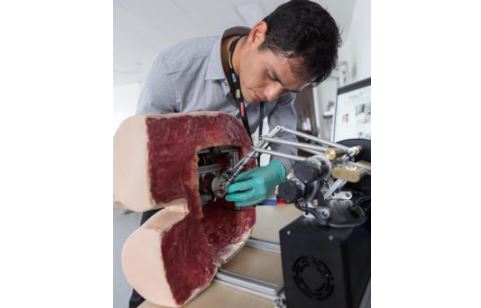
LONDON, July 6 (UPI) — Although there are plastic models used to train doctors and nurses to perform prostate exams, they are not realistic, and finding volunteers for training can be difficult because of the nature of the exam.
Doctors in England have created a robotic rectum, pairing it with 3D imaging software, to give young doctors and nurses experience performing the exams — which are based entirely on a doctor feeling the prostate with a fingertip — and could make doctors better and exams more effective.
Rectal examinations are used to diagnose prostate cancer, among other conditions, by inserting an index finger into the anus to feel the prostate gland.
The gland, a walnut-sized organ below the bladder, can be felt through the rectal wall and feels “hard and knobby” when cancerous, though doctors say it can be difficult to learn what a diseased one feels like.
Training can also be difficult, they say, because it is an internal organ and neither the trainer nor trainee can see what they are doing, which the 3D imaging system and robot seek to correct.
“We have already asked a number of doctors and nurses — including prostate specialists and cancer surgeons — to trial the technology,” Dr. Alejandro Granados, a researcher at Imperial College London, said in a press release. “They commented on the great advantage of being able to alter the anatomy. The size and shape of the rectum and prostate can vary greatly from person to person, and this technology enables medics to practice their skills in many different virtual patients. They also observed that because these examinations are performed solely by feel, experiencing a realistic sensation is crucial.”
To use the system, which will be presented at the Eurohaptics conference this week, a doctor inserts a finger inside the robot, which mimics the sensation of the human rectum and can be programmed for different health and anatomy scenarios, unlike a standard plastic rectum.
During examination, the system displays the rectum and prostate on a computer screen behind the robot, as well as projecting an image on 3D glasses worn by doctors.
Scientists continue to work on the device, asking doctors involved with its development to wear small pressure sensors on their fingertip when examining real patients in order to perfect the pressure and trajectory a doctor needs to successfully perform a prostate test.
“Internal examinations are really challenging to learn — and to teach,” Bello said. “Because the examinations occur in the body, the trainer cannot see what the trainee is doing, and vice versa. In addition to this, medics rarely get the chance to practice the examination, as few patients would volunteer as practice subjects. In fact there is only one person registered in the country as a test subject, called a Rectal Teaching Assistant in the UK.
“But the results of these examinations can have major implications for patients — they are very important for early diagnosis of various conditions such as prostate cancer.”





